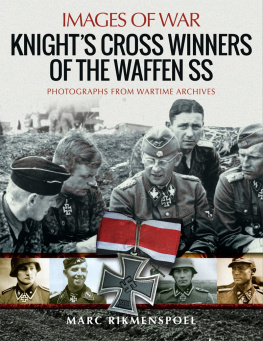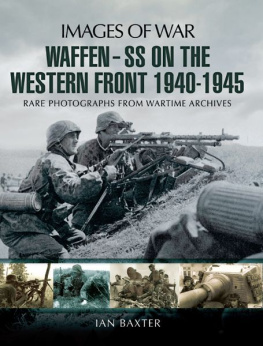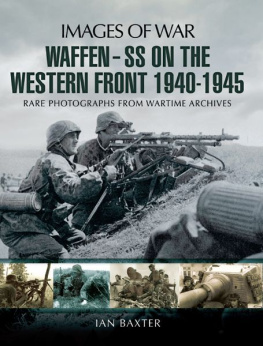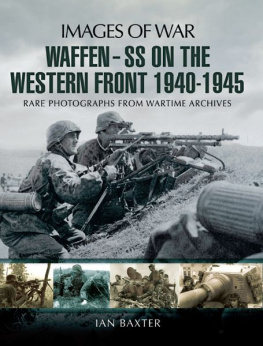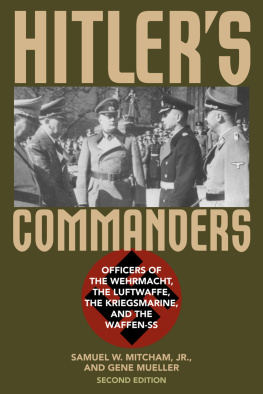Pagebreaks of the print version

IMAGES OF WAR
KNIGHTS CROSS WINNERS OF THE WAFFEN SS
RARE PHOTOGRAPHS FROM WARTIME ARCHIVES
IMAGES OF WAR
KNIGHTS CROSS WINNERS OF THE WAFFEN SS
RARE PHOTOGRAPHS FROM WARTIME ARCHIVES
MARC RIKMENSPOEL
First published in Great Britain in 2020 by
PEN & SWORD MILITARY
An imprint of
Pen & Sword Books Ltd
Yorkshire Philadelphia
Copyright Marc Rikmenspoel 2020
ISBN 978 1 52676 758 5
eISBN 978 1 52676 759 2
Mobi ISBN 978 1 52676 760 8
The right of Marc Rikmenspoel to be identified as Author of this work has been asserted by him in accordance with the Copyright, Designs and Patents Act 1988.
A CIP catalogue record for this book is available from the British Library.
All rights reserved. No part of this book may be reproduced or transmitted in any form or by any means, electronic or mechanical including photocopying, recording or by any information storage and retrieval system, without permission from the Publisher in writing.
Pen & Sword Books Limited incorporates the imprints of Atlas, Archaeology, Aviation, Discovery, Family History, Fiction, History, Maritime, Military, Military Classics, Politics, Select, Transport, True Crime, Air World, Frontline Publishing, Leo Cooper, Remember When, Seaforth Publishing, The Praetorian Press, Wharncliffe Local History, Wharncliffe Transport, Wharncliffe True Crime and White Owl.
For a complete list of Pen & Sword titles please contact
PEN & SWORD BOOKS LIMITED
47 Church Street, Barnsley, South Yorkshire, S70 2AS, England
E-mail:
Website: www.pen-and-sword.co.uk
Or
PEN AND SWORD BOOKS
1950 Lawrence Rd, Havertown, PA 19083, USA
E-mail:
Website: www.penandswordbooks.com
Introduction
The Waffen-SS was many things. It was an elite force of carefully-recruited men with superior physiques. It was an assembly of foreigners, some with no affiliation with Germany or far-right politics. It was armored divisions, mountain divisions, infantry formations, and even horsed cavalry.The Waffen-SS defies generalization.
The men portrayed in this book were volunteers, unlike many soldiers conscripted or assigned to the Waffen-SS later in the war. Most wanted to be soldiers, while others were reservists who originally served as uniformed policemen or political activists. The SS existed to advance Nazi ideology, though over time it came to represent itself, for example in carrying out a foreign policy distinct from that of Nazi Germanys Foreign Ministry. The men who served in the military branch of the SS, the Waffen-SS, from before the war, or from the early phase of the war, understood that part of their role was to be more than soldiers, by advancing SS and Nazi policies.
This was shown by the participation of Waffen-SS elements in the activities of the Einsatzgruppen murder squads, and in other killings of prisoners and civilians.The invasions of Poland and the Soviet Union were intended to lead to the enslavement of those countries, and German casual cruelty was displayed by many parts of the occupation forces, not only the SS and its military Waffen-SS.This also happened to a lesser extent in other occupied territories.
With all this said, the Waffen-SS primarily fought as soldiers, and often at the most important points of the Western and Eastern Fronts. The fighting in the Soviet Union was some of the largest-scale, long-lasting, and most-intense in all of history. The Waffen-SS expanded in an attempt to meet the needs of a prolonged war, and most of its senior units became armored or partially-armored.
The Waffen-SS possessed press and propaganda services proportionally far greater than those of the rest of the German military. The early Waffen-SS divisions fought in many significant battles, and received extensive coverage of their participation. This extended to a liberal distribution of medals and awards, and many photographs of the decorated men.
Some of those photos are shown in this book, which tries to portray a representative selection of Knights Cross winners and their units.The scope of this book series does not allow comprehensive coverage, and the captions focus on the medals shown and the justification for their awarding. Much of the information I provide is expanded upon in my other books, or in the ones listed for further reading. I have tried to show both the extreme heroism most Waffen-SS Knights Cross winners displayed, and the darker stories in the background.
Some details didnt fit, and for every photo there was more to tell. When Kurt Meyer is shown smiling with Wilhelm Mohnke, it should be remembered that Meyer destroyed two Ukrainian villages after the death of a friend, and that Mohnke is believed to be responsible for the killing of prisoners in 1940 and 1944. Eberhard Heder had distinguished careers in the Waffen-SS and the postwar Bundeswehr. However, a recent study includes an accusation that during 1941 he was active in looting Jewish possessions in Galicia. I hope that readers will remember that a man can be both a hero and a villain, or can perform heroic actions while serving a bad cause. It should also be realized that while the Knights Cross winners of the Waffen-SS were in no way victims, their wartime experiences demanded a high price in physical and mental scarring. Some were killed in action after winning their award, and all of them lost friends and comrades in the course of the war.The photos show the high points of their service, but it shouldnt be forgotten that, for all his happiness in his photos in this book, Fritz Witt was torn apart by a naval artillery shell in Normandy.
In my books, I attempt to put a human face on a war whose story is often told through lists, statistics, and simplistic judgements. I also shed light on campaigns that are little-known to English-language readers. Its my hope that readers come away from this book with a new appreciation of the events of the Secord World War.Thanks for reading my work.
Along with thanking the usual suspects, my thanks this time go out to Chris Evans, Andrey Zubkov, Petter Klellander, and Michael Miller.This book is dedicated to the memory of Ember, Ember Bo-bember, my beloved kitty for almost 19 years. It is also dedicated to the memory of Neil Ellwood Peart, who contributed to the soundtrack of my life for decades. Rest in peace, Mitakuye Oyasin.
Marc Rikmenspoel
Denver, Colorado
March 5, 2020
Knights Cross Winners of the Waffen-SS
The Knights Cross of the Iron Cross, in its various grades, was the highest German military award for bravery and combat success during the Second World War. The Iron Cross itself dated from 1813, during the Prussian War of Liberation. It was reactivated in 1870 for the Franco-Prussian War, and again in 1914 for the First World War.
The Knights Cross was a new addition to the Iron Cross, added on September 1, 1939. In previous wars, dating back to the eighteenth century, the Pour le Mrite had been the highest Prussian award for bravery. Its French name reflected the prevailing language of German nobility in the era of its creation. An extension of this is that it was an award for officers and aristocrats.While the Iron Cross and the Pour le Mrite were Prussian decorations, they were awarded throughout the German military, and to their allies, during the First World War.
The Iron Cross was re-activated for issue on the outbreak of the Second World War.The Pour le Mrite was not. In its place, Adolf Hitler decreed the creation of the Knights Cross of the Iron Cross.This new medal, with a German name, could be awarded to both officers and enlisted men. It recognized both outstanding bravery and successful command of important operations.

